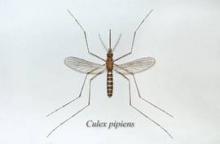The death toll associated with West Nile virus now stands at 118 – with more undoubtedly to come, federal health officials said Sept. 12.
"Deaths are likely to go up because they are a lagging indicator" of severe disease, Dr. Lyle Petersen said during a Centers for Disease Control and Prevention press briefing. "Someone with severe disease may die a week, a month, or even 6 months after becoming infected. Even if transmission stopped tomorrow – which it won’t – we would expect the death rate to continue to rise across the country."
Dallas County, Tex., and surrounding counties continue to bear the brunt of the disease, which has occurred in five other states as well (Michigan, Mississippi, Louisiana, Oklahoma, and South Dakota). In Texas alone, a total of 50 people have died during this outbreak, which includes 10 deaths since the Sept. 4 case update.
"The number of deaths in those counties reflects the high number of neuroinvasive disease" cases, Dr. Petersen said. "There have been a tremendous number of cases of severe disease in that area. We know that 8%-10% of people who develop neuroinvasive West Nile will eventually succumb to the infection."
The overall mortality is the highest reported through the second week of September in any West Nile outbreak since the disease first appeared here in 1999, said Dr. Petersen, director of CDC’s Division of Vector-Borne Infectious Disease.
So far this summer, there have been 2,636 human cases, 1,405 of which (53%) have been the serious, neuroinvasive form.
The new numbers represent a significant increase since the last update, when there were 1,993 reported cases, 1,069 neuroinvasive cases, and 87 deaths – marking 2012 as the worst West Nile outbreak ever recorded in this country.
The season, however, may be nearing its close, Dr. Petersen said. "Based on historical data, we think we have turned the corner on this epidemic. West Nile outbreaks tend to peak in mid to late August and we are hopeful that the worst is behind us."
The 2012 epidemic "has raised a number of challenging questions," he said, adding that the CDC will release a full report sometime next spring. In addition to finalized numbers, Dr. Petersen said that the report will examine environmental factors that seem to have exacerbated the outbreak and examine the virus’s genetic proclivity for virulence.
The marked increase in the number of neuroinvasive cases this year has prompted concerns about a mutation that could be making West Nile more dangerous.
"We have no reason to think the virus has become" more virulent, but a genetic comparison with prior strains is the only way to allay that fear, he said.
The 2013 report also will look at how heat and rain may have interacted to promote a higher viral load in mosquitoes and more efficient transmission to birds, animals, and humans.
"Temperature and rainfall affect a lot of things related to outbreaks," including the number and lifespan of mosquitoes, the number of birds, the way those hosts interact, and even the rate of viral growth within the mosquito and the ease of transmission into humans and animals.
National Weather Service data are being analyzed to see if it’s possible to predict where and when an outbreak might occur, Dr. Petersen said. Such models have so far failed because of the complex interplay of environmental factors. "It may take years of observation to tease this entire thing out. I’m not too optimistic that we will ever be able to say, ‘This was the cause of this year’s outbreak.’ "
There will be no more public presentations on the outbreak, Dr. Petersen added, although the CDC will continue to update case counts every Wednesday through the end of October.


